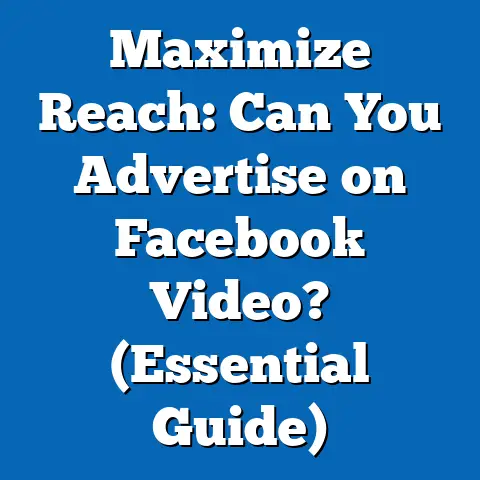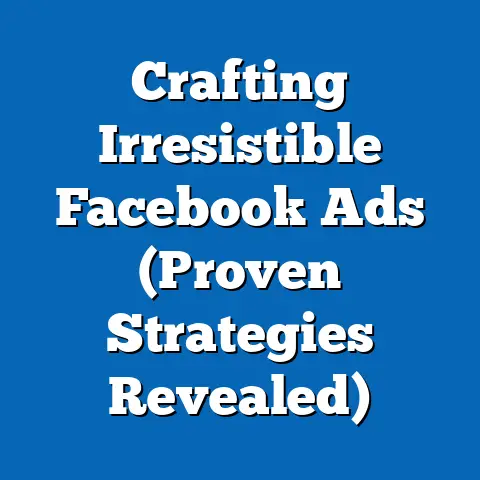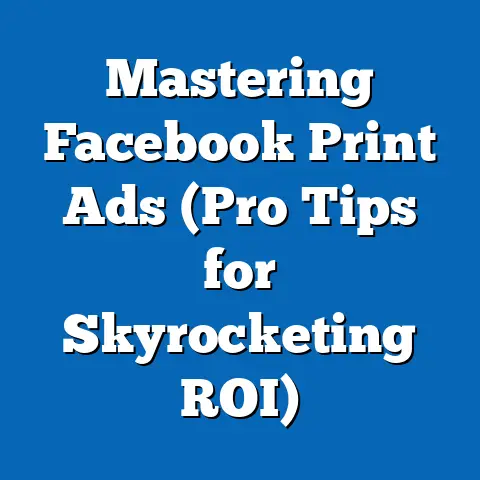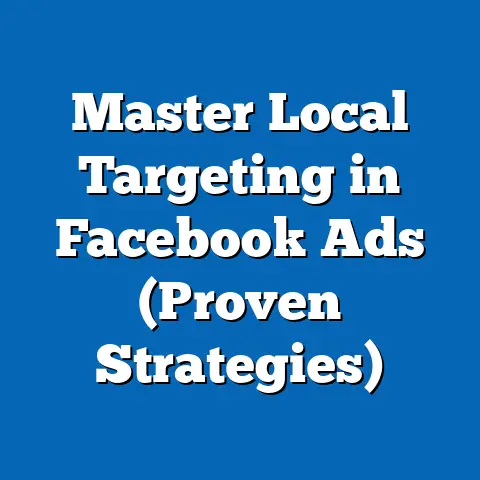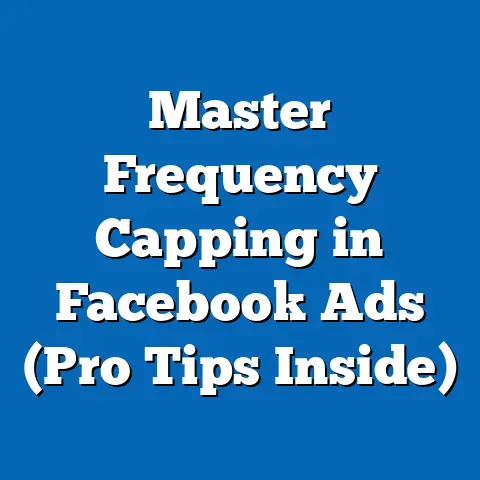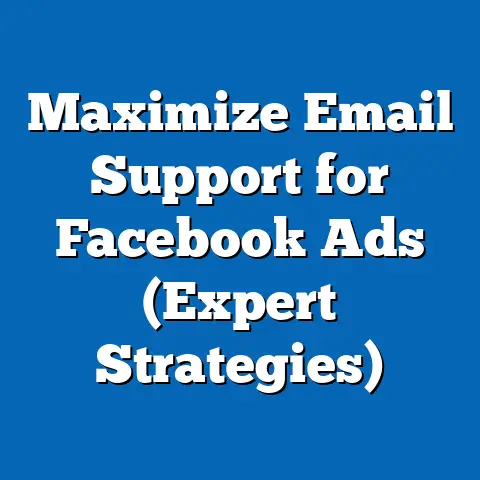Master Jason Hornung’s Facebook Ads (Proven Strategies)
Imagine a digital marketplace, a vibrant tapestry of brands vying for attention. Ads flicker across screens like neon signs, notifications ping incessantly, and entrepreneurs pour their hearts into crafting the perfect Facebook ad. In this chaotic landscape, Facebook isn’t just a social media platform; it’s a potent marketing tool, capable of catapulting a brand to stardom or sinking it into oblivion.
I’ve seen it happen firsthand – the rise and fall of businesses based solely on their Facebook advertising prowess. And that’s where figures like Jason Hornung come in. I’ve been following his work for years, and I’ve always been impressed by his results. I’ve seen Jason transform from a struggling marketer into a recognized authority, a true Facebook advertising master. Through relentless experimentation and a knack for strategic refinement, he’s unlocked the secrets to successful advertising on Facebook. His approach has reshaped the strategies of countless businesses, driving measurable results and turning ad spend into real ROI.
Section 1: Understanding the Facebook Ads Landscape
Before diving into specific strategies, it’s crucial to grasp the current state of Facebook advertising. It’s not the same platform it was even a few years ago.
The Ever-Evolving Ecosystem
Facebook’s advertising reach is undeniable. Consider these statistics:
- As of 2024, Facebook boasts nearly 3 billion monthly active users, making it a colossal marketplace for potential customers.
- Facebook ads reach approximately 34% of the world’s population aged 13 and older.
- Despite the rise of other platforms, Facebook still accounts for a significant portion of digital ad spend.
- Mobile advertising dominates, with the vast majority of Facebook users accessing the platform via their smartphones.
These numbers highlight the immense opportunity for businesses to connect with their target audience. However, the sheer volume of advertisers also means increased competition. The landscape is constantly shifting due to algorithm updates, new ad formats, and evolving user behavior.
Knowing Your Audience is Paramount
Understanding your target audience on Facebook isn’t just important; it’s the cornerstone of any successful ad strategy. I’ve seen countless campaigns fail because the advertiser hadn’t taken the time to truly understand who they were trying to reach.
- Demographics: Age, gender, location, education, job title – these are the basics. But don’t stop there.
- Interests: What pages do they like? What groups are they members of? What topics do they engage with?
- Behaviors: What are their purchase habits? What devices do they use? What are their online activities?
- Pain Points: What problems are they trying to solve? What are their frustrations?
The more you know about your audience, the more effectively you can target your ads and tailor your messaging. Facebook’s Audience Insights tool is invaluable for gathering this information.
A Buffet of Ad Formats
Facebook offers a diverse range of ad formats, each with its own strengths and weaknesses. Choosing the right format depends on your objectives, your target audience, and the story you want to tell. Here’s a quick overview:
- Image Ads: Simple and effective for showcasing products or services. High-quality visuals are essential.
- Video Ads: Highly engaging and ideal for storytelling, product demos, or brand awareness.
- Carousel Ads: Allow you to display multiple images or videos, each with its own headline, description, and link. Great for showcasing a range of products or highlighting different features.
- Slideshow Ads: Similar to video ads, but created from a series of images. A cost-effective alternative to video.
- Collection Ads: Designed for e-commerce, these ads showcase a catalog of products in a visually appealing format.
- Lead Ads: Allow users to submit their information directly within Facebook, making it easy to generate leads.
Key Takeaway: The Facebook advertising landscape is vast and complex. Understanding the platform’s reach, knowing your audience intimately, and choosing the right ad formats are crucial first steps to success.
Section 2: The Foundation of Jason Hornung’s Strategies
Now, let’s delve into the core of Jason Hornung’s approach, what I call “The Hornung Method.” It’s not a rigid set of rules, but rather a collection of principles that guide his decision-making.
The Hornung Method: A Holistic Approach
The Hornung Method rests on three foundational pillars:
- Laser-Focused Audience Targeting: Reaching the right people is paramount. Jason doesn’t believe in casting a wide net; he prefers precision targeting to maximize ROI.
- Compelling and Authentic Copywriting: Connecting with the audience on an emotional level is key. Jason’s ad copy is never generic; it’s tailored to resonate with the specific needs and desires of the target audience.
- Visually Stunning and Relevant Visuals: Grabbing attention in a crowded newsfeed requires eye-catching visuals. Jason emphasizes the importance of high-quality images and videos that are both visually appealing and relevant to the ad’s message.
These three elements work in harmony to create Facebook ads that not only grab attention but also drive conversions.
The Power of Testing and Iteration
Jason is a firm believer in the power of testing and iteration. He doesn’t assume that his initial ideas are perfect; he constantly experiments with different ad variations to see what resonates best with the audience.
- A/B Testing: Testing two versions of an ad against each other to see which performs better. This can involve testing different headlines, images, calls-to-action, or targeting options.
- Multivariate Testing: Testing multiple variations of an ad simultaneously. This allows you to identify the optimal combination of elements.
- Continuous Optimization: Regularly monitoring ad performance and making adjustments as needed. This ensures that your campaigns are always performing at their best.
I’ve personally adopted this philosophy in my own campaigns. I used to be hesitant to change things once they were running, but now I embrace testing as a crucial part of the process. I’ve seen firsthand how small tweaks can lead to significant improvements in performance.
Data: The Guiding Light
Data analytics plays a critical role in The Hornung Method. Jason doesn’t rely on gut feelings; he lets the data guide his decisions.
- Tracking Key Metrics: Monitoring important metrics such as click-through rate (CTR), conversion rate, cost per acquisition (CPA), and return on ad spend (ROAS).
- Analyzing Performance Data: Identifying trends and patterns in the data to understand what’s working and what’s not.
- Making Informed Decisions: Using the data to make informed decisions about targeting, ad copy, visuals, and bidding strategies.
Facebook Ads Manager provides a wealth of data, but it’s important to know how to interpret it. I’ve spent countless hours poring over reports, trying to decipher the story the data is telling. It’s not always easy, but it’s essential for optimizing your campaigns.
Key Takeaway: The Hornung Method is a holistic approach that emphasizes audience targeting, compelling copywriting, effective visuals, continuous testing, and data-driven decision-making.
Section 3: Crafting Compelling Ad Copy
Let’s break down one of the pillars of The Hornung Method: crafting ad copy that converts. It’s not just about writing words; it’s about understanding psychology and connecting with your audience on an emotional level.
The Anatomy of High-Converting Ad Copy
Jason’s approach to ad copywriting involves several key elements:
- Attention-Grabbing Headline: The headline is the first thing people see, so it needs to be compelling enough to stop them from scrolling. Use strong verbs, numbers, and questions to pique their interest.
- Relatable Body Text: The body text should clearly explain the benefits of your product or service and how it solves the audience’s problems. Use persuasive language and address their pain points.
- Clear Call-to-Action (CTA): The CTA tells people what you want them to do next. Use action-oriented language and create a sense of urgency.
Hornung’s Techniques: Unlocking the Secrets
Jason employs several techniques to create ad copy that resonates with the audience:
- Understanding the Target Audience: This goes back to knowing your audience intimately. Jason researches their needs, desires, and pain points to craft copy that speaks directly to them.
- Highlighting Benefits, Not Features: People don’t care about features; they care about benefits. Jason focuses on how the product or service will improve their lives.
- Using Social Proof: Incorporating testimonials, reviews, and case studies to build trust and credibility.
- Creating a Sense of Urgency: Using phrases like “Limited Time Offer” or “While Supplies Last” to encourage people to take action immediately.
- Storytelling: Weaving a compelling narrative that captures the audience’s attention and makes the ad more memorable.
Examples in Action
Let’s analyze some examples of successful ad copy, inspired by Jason’s approach:
Example 1: E-commerce Store Selling Skincare Products
- Headline: Tired of Dull Skin? Get Your Glow Back in 7 Days!
- Body Text: Our revolutionary skincare line is formulated with natural ingredients to hydrate, brighten, and rejuvenate your skin. See visible results in just one week!
- CTA: Shop Now and Get 20% Off!
Analysis: This ad copy uses a compelling headline that addresses a common pain point (dull skin). The body text highlights the benefits of the product (hydration, brightening, rejuvenation) and promises visible results. The CTA creates a sense of urgency with a limited-time offer.
Example 2: SaaS Company Offering Project Management Software
- Headline: Stop Wasting Time on Project Management!
- Body Text: Our intuitive project management software helps you streamline workflows, collaborate effectively, and stay on top of deadlines. Get more done in less time!
- CTA: Start Your Free Trial Today!
Analysis: This ad copy addresses a common frustration (wasting time on project management). The body text highlights the benefits of the software (streamlining workflows, collaboration, staying on top of deadlines). The CTA offers a free trial, making it easy for people to try the product.
The Psychology of Persuasion
Persuasive writing is an art and a science. Here are some psychological principles that Jason incorporates into his ad copy:
- Reciprocity: People are more likely to do something for you if you’ve done something for them. Offer a free ebook, a discount, or a valuable piece of content to build goodwill.
- Scarcity: People value things more when they’re scarce. Use phrases like “Limited Availability” or “Exclusive Offer” to create a sense of urgency.
- Authority: People are more likely to be persuaded by someone who is perceived as an authority. Incorporate testimonials from experts or highlight your credentials.
- Consistency: People like to be consistent with their past actions. Remind them of their past purchases or positive experiences with your brand.
- Liking: People are more likely to be persuaded by someone they like. Use a friendly, conversational tone and build rapport with your audience.
Key Takeaway: Crafting compelling ad copy is about understanding your audience, highlighting benefits, using social proof, creating urgency, and incorporating psychological principles of persuasion.
Section 4: Designing Eye-Catching Visuals
Visuals are the silent salesperson in your Facebook ads. They’re what initially grabs attention and entices people to learn more. I’ve seen ads with mediocre copy succeed simply because the visuals were stunning. Jason Hornung understands this implicitly.
The Power of Visual Appeal
Visuals are processed much faster than text. In fact, studies show that the human brain processes visuals 60,000 times faster than text. This means that your visuals have a very short window of opportunity to make a positive impression.
The Hornung Approach to Visual Design
Jason’s approach to visual design is guided by several principles:
- Relevance: The visuals should be relevant to the ad’s message and the target audience’s interests.
- High Quality: The visuals should be sharp, clear, and professionally designed. Avoid using blurry or pixelated images.
- Branding Consistency: The visuals should be consistent with your brand’s identity, including colors, fonts, and overall style.
- Emotional Connection: The visuals should evoke an emotional response from the audience, whether it’s happiness, excitement, or curiosity.
Color Theory: Painting with Emotion
Color plays a significant role in how people perceive your visuals. Jason understands the psychology of color and uses it strategically to evoke specific emotions:
- Blue: Trust, security, stability
- Green: Health, nature, growth
- Red: Excitement, passion, energy
- Yellow: Optimism, happiness, creativity
- Purple: Luxury, royalty, wisdom
For example, if you’re advertising a financial product, you might use blue to convey trust and security. If you’re advertising a health food product, you might use green to convey health and nature.
Tools and Resources for Creating Stunning Visuals
You don’t need to be a professional designer to create eye-catching visuals. There are many user-friendly tools and resources available:
- Canva: A popular online design tool that offers a wide range of templates and design elements.
- Adobe Spark: Another online design tool that’s easy to use and offers a variety of features.
- Unsplash: A website that offers high-quality, royalty-free images.
- Pexels: Another website that offers high-quality, royalty-free images and videos.
I personally use Canva for most of my visual design needs. It’s incredibly versatile and easy to learn.
A/B Testing Visual Elements
Just like with ad copy, it’s important to A/B test your visual elements to see what resonates best with your target audience. Test different images, videos, colors, and layouts to identify the optimal combination.
Key Takeaway: Visuals are crucial for grabbing attention and conveying your message effectively. Focus on relevance, high quality, branding consistency, and emotional connection.
Section 5: Advanced Targeting Techniques
Basic demographic targeting is just the tip of the iceberg. To truly maximize your ROI, you need to leverage Facebook’s advanced targeting options. Jason Hornung is a master of this, using these techniques to reach niche audiences and drive exceptional results.
Beyond Demographics: Unlocking the Power of Precision
Facebook’s advanced targeting options allow you to target people based on:
- Interests: What pages do they like? What groups are they members of? What topics do they engage with?
- Behaviors: What are their purchase habits? What devices do they use? What are their online activities?
- Custom Audiences: Uploading a list of your existing customers or website visitors to target them specifically.
- Lookalike Audiences: Creating a new audience that’s similar to your existing customers or website visitors.
Custom Audiences: Targeting Your Tribe
Custom audiences are incredibly powerful because they allow you to target people who have already interacted with your brand. There are several types of custom audiences:
- Customer List: Uploading a list of your existing customers with their email addresses or phone numbers.
- Website Traffic: Targeting people who have visited your website or specific pages on your website.
- App Activity: Targeting people who have used your mobile app.
- Engagement: Targeting people who have engaged with your content on Facebook or Instagram.
I’ve seen firsthand how effective custom audiences can be. By targeting people who have already shown an interest in my products or services, I’ve been able to significantly increase my conversion rates.
Lookalike Audiences: Expanding Your Reach
Lookalike audiences allow you to reach new people who are similar to your existing customers or website visitors. This is a great way to expand your reach and find new potential customers.
Facebook uses its algorithm to identify the characteristics and behaviors of your source audience (e.g., your existing customers) and then finds other people who share those same characteristics and behaviors.
Retargeting: Bringing Them Back
Retargeting is the practice of showing ads to people who have previously interacted with your website or app but didn’t complete a desired action (e.g., made a purchase). This is a highly effective way to remind people about your products or services and encourage them to come back and complete the transaction.
Example: Someone visits your e-commerce store and adds a product to their cart but doesn’t complete the checkout process. You can then show them a retargeting ad featuring that product, reminding them to complete their purchase.
Case Studies: Targeting Success
Let’s look at some real-world examples of how Jason Hornung has used advanced targeting to enhance campaign performance:
- E-commerce Store Selling Pet Supplies: Jason created a custom audience of people who had purchased pet food from the store in the past. He then created a lookalike audience based on that custom audience to reach new potential customers who were likely to be pet owners.
- SaaS Company Offering Marketing Automation Software: Jason targeted people who had visited the company’s website and downloaded a free ebook about marketing automation. He then showed them a retargeting ad offering a free trial of the software.
Key Takeaway: Advanced targeting techniques allow you to reach niche audiences and drive exceptional results. Leverage custom audiences, lookalike audiences, and retargeting strategies to maximize your ROI.
Section 6: Scaling Campaigns Effectively
Once you’ve found a winning ad campaign, the next step is to scale it effectively. But scaling isn’t just about increasing your budget; it’s about doing it strategically to maintain performance and avoid ad fatigue. Jason Hornung has developed methods for scaling campaigns without sacrificing quality or ROI.
The Art of Sustainable Growth
Scaling Facebook ad campaigns requires a delicate balance between increasing your budget and maintaining your targeting and creative quality. Here’s how Jason approaches it:
- Gradual Budget Increases: Avoid making drastic changes to your budget. Increase it gradually (e.g., 10-20% per day) to allow Facebook’s algorithm to adjust.
- Expanding Your Audience: Once you’ve saturated your initial target audience, expand your reach by using lookalike audiences or targeting broader interests.
- Refreshing Your Creative: Ad fatigue is a real problem. Regularly refresh your ad creative (images, videos, and copy) to keep your audience engaged.
- Monitoring Performance Closely: Keep a close eye on your key metrics (CTR, conversion rate, CPA, ROAS) to ensure that your performance doesn’t decline as you scale.
Budget Allocation: Spreading the Wealth
How you allocate your budget across different ad sets and campaigns can have a significant impact on your overall performance. Jason recommends the following strategies:
- Prioritize High-Performing Ad Sets: Allocate more budget to the ad sets that are generating the best results.
- Test New Ad Sets with a Smaller Budget: Don’t put all your eggs in one basket. Test new ad sets with a smaller budget to see if they can generate positive results.
- Use Campaign Budget Optimization (CBO): Let Facebook’s algorithm automatically allocate your budget across different ad sets based on their performance.
Bidding Strategies: Finding the Sweet Spot
Choosing the right bidding strategy is crucial for maximizing your ROI. Facebook offers several bidding strategies:
- Lowest Cost: Facebook will try to get you the most results for your budget. This is a good option for beginners.
- Cost Cap: You set a target cost per result, and Facebook will try to stay within that target.
- Bid Cap: You set a maximum bid for each auction, giving you more control over your spending.
- Target Cost: Facebook will try to get you results at your target cost.
- Minimum ROAS: Facebook will try to get you a minimum return on ad spend.
Jason typically recommends using the Cost Cap or Bid Cap strategies to maintain more control over your spending.
Recognizing the Right Time to Scale
Knowing when to scale is just as important as knowing how to scale. Jason looks for the following signs that a campaign is ready to be scaled:
- Consistent Positive ROI: The campaign is consistently generating a positive return on ad spend.
- Stable Performance: The campaign’s performance metrics (CTR, conversion rate, CPA) are stable and not declining.
- Sufficient Budget: You have enough budget to scale the campaign without significantly impacting its performance.
Key Takeaway: Scaling Facebook ad campaigns effectively requires a gradual approach, strategic budget allocation, the right bidding strategies, and careful monitoring of performance.
Section 7: Overcoming Common Challenges
Even the most experienced Facebook advertisers face challenges from time to time. Ad fatigue, low engagement, and policy compliance are just a few of the hurdles you might encounter. Jason Hornung has developed strategies for overcoming these challenges and keeping your campaigns on track.
Battling Ad Fatigue: Keeping it Fresh
Ad fatigue occurs when your audience becomes tired of seeing the same ads over and over again. This can lead to a decline in performance metrics. Here’s how Jason combats ad fatigue:
- Refreshing Creative: Regularly update your ad images, videos, and copy.
- Rotating Ad Formats: Experiment with different ad formats (image ads, video ads, carousel ads) to keep things interesting.
- Expanding Your Audience: Target new segments of your audience or create lookalike audiences to reach fresh prospects.
- Pausing and Restarting Campaigns: Sometimes, simply pausing a campaign for a few days and then restarting it can help to overcome ad fatigue.
Boosting Engagement: Sparking Interaction
Low engagement can be a sign that your ads aren’t resonating with your audience. Here are some tips for boosting engagement:
- Ask Questions: Pose questions in your ad copy to encourage people to comment and share their thoughts.
- Run Contests and Giveaways: Offer prizes to people who engage with your ads.
- Use Interactive Ad Formats: Experiment with interactive ad formats like polls and quizzes.
- Respond to Comments and Messages: Engage with your audience and respond to their comments and messages promptly.
Navigating Policy Compliance: Staying Within the Lines
Facebook has strict advertising guidelines that you need to adhere to. Violating these guidelines can result in your ads being disapproved or your account being suspended. Here are some tips for staying compliant:
- Familiarize Yourself with the Guidelines: Read Facebook’s advertising guidelines carefully and make sure you understand them.
- Avoid Making Misleading Claims: Don’t make false or exaggerated claims about your products or services.
- Respect Copyright Laws: Don’t use copyrighted images or music without permission.
- Be Transparent About Data Collection: Disclose how you collect and use user data.
The Importance of Community Engagement
Jason believes that community engagement is essential for refining ad strategies. He actively participates in online forums and social media groups, sharing his knowledge and learning from others.
Key Takeaway: Overcoming common challenges requires proactive measures, such as refreshing creative, boosting engagement, and staying compliant with Facebook’s advertising guidelines.
Section 8: Success Stories and Real-World Applications
Theory is great, but seeing real-world results is what truly inspires action. Jason Hornung’s strategies have been implemented across diverse industries, leading to measurable improvements in advertising results. Let’s look at a few success stories.
Case Study 1: Local Restaurant Boosts Reservations
A local restaurant was struggling to attract new customers. They implemented Jason’s targeting strategies, focusing on people who lived nearby and had an interest in dining out. They also created visually appealing ads showcasing their menu items.
Results:
- Reservations increased by 40% within one month.
- Cost per acquisition (CPA) decreased by 25%.
Case Study 2: E-commerce Store Increases Sales
An e-commerce store selling handmade jewelry was struggling to generate sales. They implemented Jason’s ad copywriting techniques, focusing on highlighting the unique benefits of their products and creating a sense of urgency. They also used high-quality product photos.
Results:
- Sales increased by 60% within two months.
- Return on ad spend (ROAS) increased by 30%.
Case Study 3: SaaS Company Generates More Leads
A SaaS company offering marketing automation software was struggling to generate leads. They implemented Jason’s advanced targeting strategies, focusing on people who had visited their website and downloaded a free ebook. They also offered a free trial of their software in their ad copy.
Results:
- Leads increased by 50% within three months.
- Cost per lead (CPL) decreased by 20%.
The Common Thread: Actionable Strategies
These success stories highlight the practical application of The Hornung Method. They demonstrate that success is achievable with dedication, the right knowledge, and a willingness to experiment.
Key Takeaway: Success stories from diverse industries demonstrate the practical application of The Hornung Method and reinforce the idea that success is achievable with dedication and the right knowledge.
Conclusion: The Road Ahead in Facebook Advertising
Mastering Facebook ads is more important than ever in today’s digital landscape. The platform continues to evolve, and advertisers need to stay up-to-date with the latest trends and best practices.
Jason Hornung’s contributions to the field have been invaluable. His strategies have helped countless businesses achieve their advertising goals. I hope this article has inspired you to take actionable steps in your own advertising efforts.
Remember, success in Facebook advertising requires a combination of knowledge, creativity, and perseverance. Don’t be afraid to experiment, test new ideas, and learn from your mistakes. With dedication and the right approach, you can achieve your advertising goals and grow your business.
So, go forth and conquer the world of Facebook advertising! Armed with newfound knowledge and confidence, you’re ready to tackle your Facebook ad campaigns and achieve remarkable results. The digital marketplace awaits!

